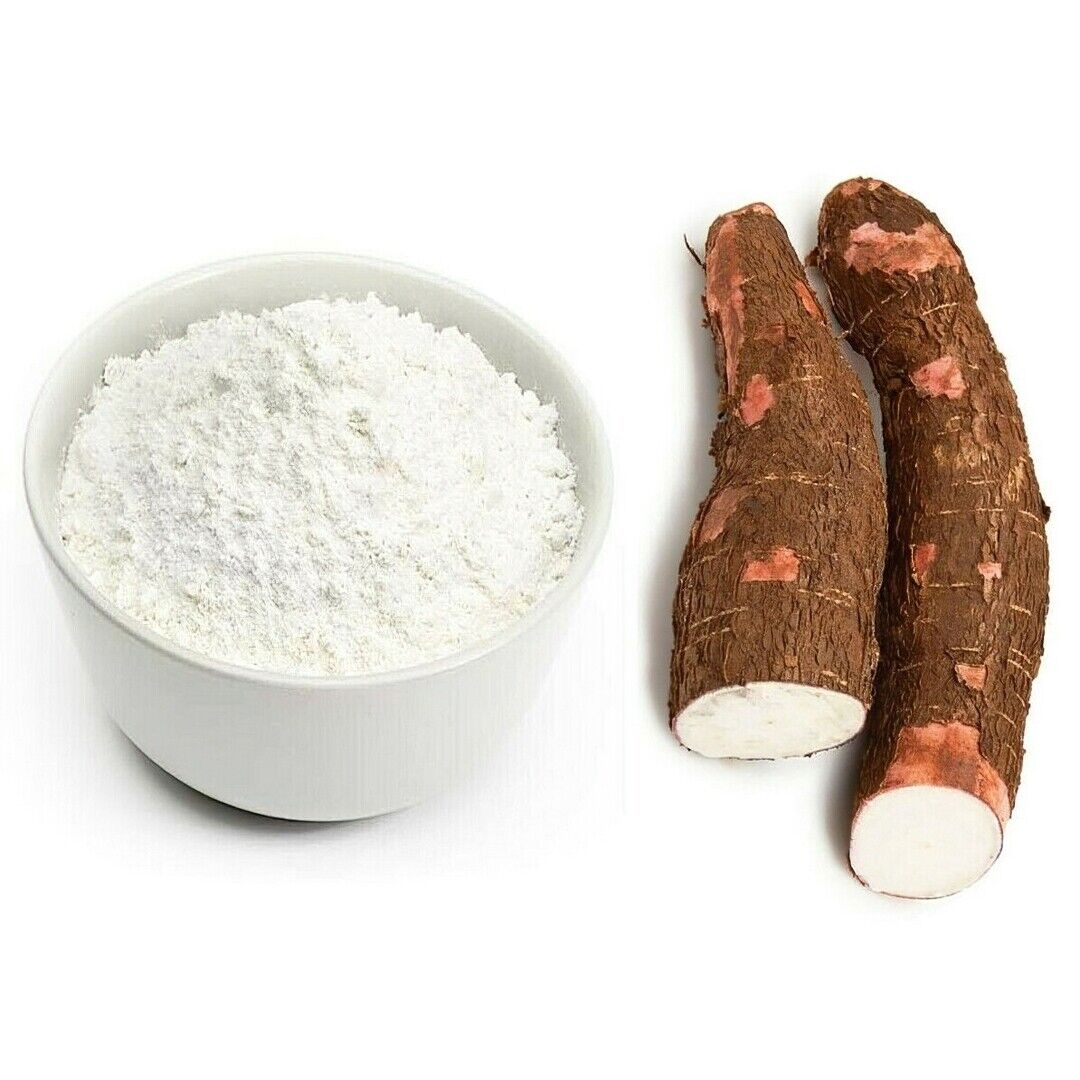Cassava flour: What it is, uses, benefits, recipes, and more


Cassava, a root vegetable originally from South America and now widely grown in tropical areas of Africa, Asia and Latin America, is an integral food source for about 800 million people around the globe. Known scientifically as Manihot esculenta Crantz or simply yucca, this starchy tuberous plant serves primarily as a renewable resource for flour production.
The cassava flour industry has witnessed notable interest surge within recent years due to market research influences. According to Market Research Future's report, the cassava market was worth USD 175.9 billion in 2022 and it’s projected to expand from USD 183.25 billion in 2025 up to nearly USD 254.28 billion by the end of -2032 showcasing approximately 4 .18% CAGR during these forecasted timespans (between year 2025-2032).
What seems like driving factors behind its mounting popularity include: adaptability making it an easy replacement for standard wheat flours; hypoallergenic properties ideal for consumers with either sensitivity or allergies towards other grains; abundant fibre content beneficial digestion coupled with robust shelf life.
Nonetheless despite all benefits initially grasping potential applications may seem intimidating therefore exploring wider aspects relating what Cassava Flour exactly is constituted by becomes necessary alongside visualising potential merits through common usage examples featuring staple recipes will be considered.

Cassava flour is derived from the whole root of the cassava plant, scientifically known in taxonomy as Manihot esculenta. Originating in South America, this tropical staple provides a critical source of calories for millions across Africa and Asia.
The process of creating cassava flour involves peeling roots before thoroughly washing, grating into fine mash followed by sun drying. Subsequently, it’s ground down further resulting in a delicately textured powdery substance closely resembling traditional wheat flour making it an ideal substitute for those following a gluten-free diet.
Interestingly enough about cassava plant itself - beyond its nutritional yield adds considerable resilience, bearing the capacity to tolerate poor soils alongside its ability to withstand drought conditions underlying why so prevalent within developing countries’ diets where access to other staples might prove challenging due to harsh climates or unyielding terrains.
A common point often arising around dietary discussions pertains to differences between Cassava Flour versus Tapioca Flour. Despite being sourced from the same tuber there lies significant disparity both terms mustn't be interchangeably used.
Tapioca fundamentally extracted starch obtained once cassavas peeled then washed with residue left behind shaped into some form either flat thin flakes or pearls all while eliminating fiber protein rich pulp part seen as largely inappropriate considering these beneficial nutrients get lost during refining consequently leading rather isolated high-carb low-natural nutrient product which isn't case happenstance when dealing directly versatile yet authentic counterpart notably referred as Cassava Flour.
Renowned for its versatility, cassava flour finds itself increasingly at the heart of various culinary applications. In particular, it is a popular choice in cooking and baking operations where traditional flours are typically used.
Cassava flour stands as an excellent replacement in recipes calling for wheat or other grain-based flour due to its neutral taste and fine texture. It swaps well with regular white flour on a one-to-one ratio making recipe adaptations a stress-free process yielding similar consistency baked goods without disturbing original flavours otherwise inherent within dishes.
An assortment of recipes from diverse gastronomies incorporates the use of cassava flour showcasing just how adaptable ingredient truly is - be it soft chewy cookies retaining their moist interiors whilst exposed rugged exteriors; freshly rolled tortillas exhibiting pliable characteristic essential wrapping around sizzling fillings; airy light flatbreads perfect accompaniment any Mediterranean spread; even fluffy pancakes which manage retain richness despite being a devoid customary wheat basis.
Those seeking more adventurous ways to integrate Cassava Flour onto plates might turn towards ethnic cuisines such as Caribbean Jamaican bammy – essentially a fried cake variant renowned among local islanders. Meanwhile, Brazilian home cooks long-held tradition shaped into pão de queijo (cheese bread) bringing together starchy base cheesy goodness resulting in snackable bites loved nationwide shedding light on wide-ranging potential embodied by humble tuber ground form.

Cassava flour's unique nutritional profile and gluten-free properties offer noteworthy health benefits, particularly for those with celiac disease or gluten sensitivities. As per estimates by Coeliac UK, approximately 1% of the British population is diagnosed as being coeliac implying significant prevalence where alternative dietary accommodations like cassava flour become indeed necessary.
One major advantage lies in its inherent nature to be completely free from any traces of gluten - a common protein found within wheat and other grains that proves troublesome for individuals suffering intolerances towards it leading to adverse reactions upon ingestion often manifesting through discomfort up until severe damages lining the digestive system, specifically small intestines.
In contrast, the cassava plant grants an utterly neutral yet nutrient-dense base suitable majority excluding risks associated with otherwise prevalent allergens proving beneficial, especially concerning gut-related conditions since fibre-rich constitution aids in maintaining healthy bowel function alongside lowering risk developing chronic diseases such as heart disease, diabetes, and stroke.
Beyond offering reprieve gastrointestinal issues noted advantages come into fruition considering a wider wellness perspective too due presence of vitamins and minerals each serving delivers. Vitamins C and K round off antioxidative attributes whilst trace elements including calcium, zinc, and magnesium provide essential utilities ranging from bone maintenance to energy production and immune support respectively.
While cassava flour holds a multitude of benefits, a few considerations must be taken into account for its consumption. Critical among these involves the presence of anti-nutrients within raw form tuber such as phytates tannins potentially interfering with the absorption of essential minerals like calcium iron zinc body.
Beyond stated, a particularly alarming concern revolves around cyanogenic glycosides which - if consumed in excess or improperly processed - can result in a development condition known as Konzo eventually leading to paralysis and long-lasting damage to the central nervous system. This underscores the importance of taking due diligence to ensure safety during preparation ideally involving steps of peeling, soaking, drying , grinding, and cooking all aimed at substantially reducing potential toxic risks associated with natural plant compounds.
Comparing Cassava Flour with alternative flours necessitates a comprehensive understanding of the individual properties inherent in grains derived. For instance, almond coconut rice oat flours each carry distinct tastes textures varying levels of nutrients and dietary fibre making it significantly ponder upon incorporating them diet attempts to move away from conventional wheat basis while also accounting factors, allergies tolerances ultimately enabling most informed decisions based on both health culinary palette preferences alike.

Exploring the realm of cassava flour in culinary applications, myriad delicious recipes pay homage to this versatile ingredient. Among these are dishes like pancakes, bread, and tortillas that bring out its best qualities.

Ingredients needed include 1 cup cassava flour, two tablespoons coconut sugar or sweetener preference, 2 teaspoons baking powder, a pinch of salt, 2 large eggs beaten lightly, ¾ cup almond milk (or other non-dairy substitutes), and finally vanilla extract for added flavouring.
Simply mix dry ingredients before gradually incorporating wet counterparts until batter forms. Heat the pan over medium heat greasing a generous amount of oil and butter and allowing the pancake to cook for about three minutes each side is done correctly golden crispy edges form while the centre stays fluffy and soft serving warm alongside your favourite toppings choice.

Begin by preheating the oven at least ten minutes before the baking process. Ingredients implemented here comprise around one-third cup of cassava flour tablespoon of psyllium husk adding structure loaf; a quarter teaspoon of sea salt hint of savoriness; half a teaspoon of active dry yeast which serves as a vital agent fermentation process leading to the eventual rise of dough resulting airy texture on inside crunchy exterior crusts; third cup warm water necessary activating aforementioned yeast; plus additional optional garnish has been sesame seeds atop sprinkle purpose.
Prepare to stand mixer paddle attachment then combine all listed components aside part designated watering let sit approximately five to seven minutes so become frothy afterward stirring regular intervals ensuring everything is well incorporated and evenly distributed throughout mixture hence getting kneaded into smooth elastic ball leave risen double size covered damp cloth kitchen towel vicinity warmth allow successful proving stage could take anywhere between an hour ninety depending environment conditions thereafter transferring onto appropriate vessel tin bake minimal forty-five sixty timing dependent personal preferential browning level desiring achieve post completion always good practice performing skewer test if comes clean guarantees readiness removing cooling sufficient duration slicing consumption.
Gather materials necessitated among them half cup cassava flour; quarter teaspoon salt incorporates desirable salinity element; two tablespoons olive oil furnishing fatty richness coming together producing supple dough not too stiff yet yielding enough be rolled out thin shapes manageable handling further cooking sessions.
Follow similar kneading steps mentioned above in the bread recipe but the difference is that it doesn't require leavening agents since tortillas expect a flat unleavened nature which serves favour, especially wrapping stuffing fillings because stability holds form under weights. Heat a non-stick pan with medium-high heat before placing each round disc swiftly flip after a couple of minutes or until bubbles pop the surface indicating forming patches of brown spots translating into a charring effect impart deeper complex notes eating.
In terms of tips and tricks for making most cassava flour culinary experiments, vital to remember differs traditional wheat flour usage sense absorbs less liquids hence recipe adjustments are needed accordingly while noting ratio replacement other types unlike the rest might vary slightly due to unique natural properties present within tuber root substance itself demanding more moisture retention compared mainstream counterparts. Lastly, considering it a relatively novel ingredient many home cooks have been accustomed to working with, it is important to remain patient. Trial and error determining optimal measurement proportions helps achieve results and determine whether dishes are savoury or sweet.
Cassava flour, extracted from the root of Manihot esculenta, is experiencing surging popularity due to its inherent nutritious benefits and versatility in cooking. It's noted for being a gluten-free alternative that seamlessly replaces traditional wheat flour, finding utility in an array of recipes ranging from breads and tortillas to cakes and cookies.
However valuable it might be as a food staple globally, caution must indeed be exercised given the presence of anti-nutrients along with cyanogenic glycosides within raw cassava form. Thus safety measures involve proper preparation methods ensuring not just safe consumption but also maintaining nutritional integrity making Cassava Flour such a sought-after component of modern healthy diets.
Cassava flour holds its ground as an excellent ingredient in gluten-free baking, serving ideally for breads, cakes, cookies, and pancakes. Its neutral taste doesn't interfere with flavours of other ingredients making it a favourite among home bakers.
Cassava offers an array of health benefits, the key among these being its provision of energy due to its high-carb profile. It supports digestive health through decent fibre content and assists in weight management with its low-fat component. Boosting immune functions is achievable owing to vitamins C and folate present as it stands out as a vegan source protein while contributing towards bone integrity via calcium reserves. Cassava promotes red blood cell production enriched by iron availability alongside supporting eyesight courtesy of Vitamin A abundance. Acting resistance against harmful toxins stems from antioxidants found naturally within tuber root form encouraging optimal brain function through a balanced ratio of copper phosphorus zinc - essential minerals all maintaining cerebral development activity.
High-quality cassava flour is predominantly used directly within the food industry application scope ranging from preparation of convenience meals like frozen entrees or lunch packets; to key element specialised dietary products catering to those requiring specific needs such as hypoallergenic consumers to celiac sufferers others seeking organic certified goods late trends leaning towards healthier lifestyle choices.
Broadly, cassava flour proves integral in diverse culinary scenarios. It acts as a base for doughs, essential stews, and soups where it serves as a thickening agent while maintaining moisture levels in baked goods even without traditional wheat presence. This elevates its gastronomical appeal globally irrespective of cuisine background due to natural adaptability beyond mere dietary restrictions. Its success not just lies within texture variations or taste enhancements but extends into enriching meal options contributing towards satisfying eating patterns aligned with modern nutrition advancements.








Plus get the inside scoop on our latest content and updates in our monthly newsletter.